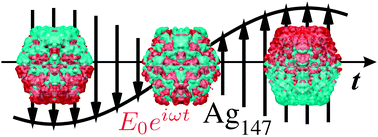Surface plasmons in quantum-sized noble-metal clusters: TDDFT quantum calculations and the classical picture of charge oscillations†
Abstract
The localized surface-plasmon resonance of metal nanoparticles corresponds to a classical charge oscillation of the quasi-free conduction electrons. In the case of noble-metal nanoparticles, interband transitions from the d electrons influence the spectra strongly. In addition, the inhomogeneity of the nanoparticles at the atomistic level becomes important for small sizes. Using the time-evolution formulation of time-dependent density-functional theory, we show that in spherical 147-atom silver clusters, the localized surface-plasmon resonance corresponds indeed to a collective charge oscillation resembling the schematic picture, while the dynamics in a comparable gold cluster shows multiple modes which correspond to the spectra without strong resonance. Short nanorods show the same difference between Au and Ag. However, nanorods of high aspect ratio develop a silver-like charge oscillation. Monatomic silver chains behave similarly to the nanorods and show a clear transverse charge oscillation mode. The role of the d electrons in the screening of the localized surface-plasmon resonance is demonstrated.

- This article is part of the themed collection: Recent advances in the chemical physics of nanoalloys

 Please wait while we load your content...
Please wait while we load your content...